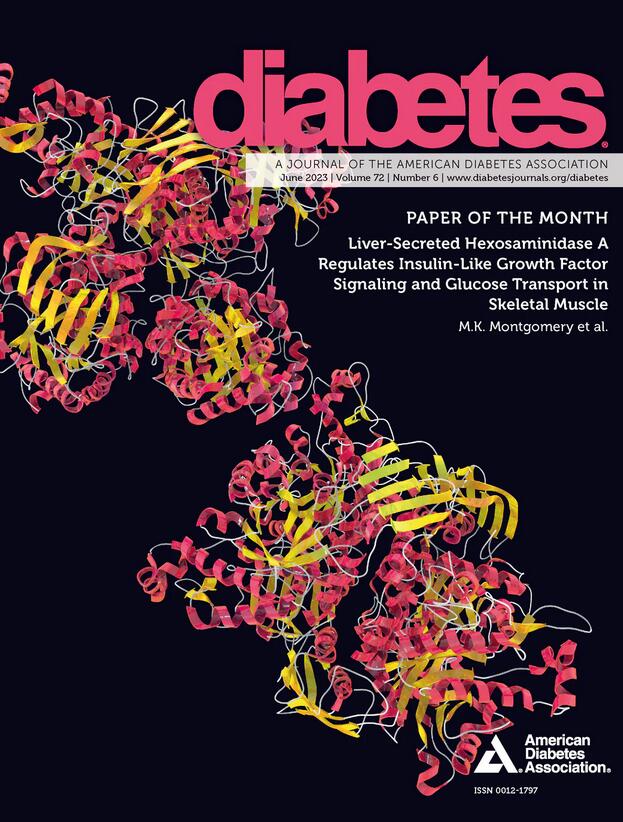胰岛自身抗体阳性高危人群中新型T细胞对混合型胰岛素肽的反应
IF 6.2
1区 医学
Q1 ENDOCRINOLOGY & METABOLISM
引用次数: 0
摘要
1型糖尿病(T1D)是由自身反应性T细胞介导的自身免疫性疾病。我们的研究表明,CD4 T细胞对混合胰岛素肽(HIPs)的反应在T细胞介导的β细胞破坏中起关键作用。我们已经证明,在人类胰岛中,在c肽片段和分泌颗粒蛋白的切割产物之间形成HIPs。为了确定与T1D发病机制有关的T细胞特异性,我们使用IFN-γ ELISPOT检测T1D患者或健康对照的T细胞对240个c肽HIPs文库的反应性。我们观察到,在c肽的氨基酸残基G15、A18和L26处形成的含有HIPs的肽池会提高T细胞的反应。在第二组健康对照、高危个体和T1D患者中,监测了T细胞对这三个残基形成的HIPs的反应性。结果表明,在T1D临床发病之前,对多个HIPs池的反应显著升高,并且T细胞对c肽残基A18处形成的HIPs的反应程度增加。总的来说,我们的研究在高危人群中发现了新的T细胞特异性,并表明在T1D发病之前可以观察到T细胞对HIPs的反应性。本文章由计算机程序翻译,如有差异,请以英文原文为准。
Novel T Cell reactivities to Hybrid Insulin Peptides in Islet Autoantibody-Positive At-Risk Subjects
Type 1 Diabetes (T1D) is an autoimmune disease mediated by autoreactive T cells. Our studies indicate that CD4 T cells reactive to Hybrid Insulin Peptides (HIPs) play a critical role in T cell-mediated beta-cell destruction. We have shown that HIPs form in human islets between fragments of the C-peptide and cleavage products of secretory granule proteins. To identify T cell specificities contributing to T1D pathogenesis, we tested T cell reactivity from T1D patients or healthy control using an IFN-γ ELISPOT assay against a library of 240 C-peptide HIPs. We observed elevated T cell responses to peptide pools containing HIPs that form at the amino acid residues G15, A18 and L26 of C-peptide. In a second cohort of healthy controls, at-risk individuals, and T1D patients, T cell reactivity to HIPs forming at these three residues was monitored. Results indicate that, prior to clinical onset of T1D, there were significantly elevated responses to multiple pools of HIPs, and the magnitude of T cell reactivity to HIPs forming at residue A18 of the C-peptide was increased. Overall, our study identifies new T cell specificities in at-risk subjects and indicates that T cell reactivity to HIPs can be observed before T1D onset.
求助全文
通过发布文献求助,成功后即可免费获取论文全文。
去求助
来源期刊

Diabetes
医学-内分泌学与代谢
CiteScore
12.50
自引率
2.60%
发文量
1968
审稿时长
1 months
期刊介绍:
Diabetes is a scientific journal that publishes original research exploring the physiological and pathophysiological aspects of diabetes mellitus. We encourage submissions of manuscripts pertaining to laboratory, animal, or human research, covering a wide range of topics. Our primary focus is on investigative reports investigating various aspects such as the development and progression of diabetes, along with its associated complications. We also welcome studies delving into normal and pathological pancreatic islet function and intermediary metabolism, as well as exploring the mechanisms of drug and hormone action from a pharmacological perspective. Additionally, we encourage submissions that delve into the biochemical and molecular aspects of both normal and abnormal biological processes.
However, it is important to note that we do not publish studies relating to diabetes education or the application of accepted therapeutic and diagnostic approaches to patients with diabetes mellitus. Our aim is to provide a platform for research that contributes to advancing our understanding of the underlying mechanisms and processes of diabetes.
 求助内容:
求助内容: 应助结果提醒方式:
应助结果提醒方式:


